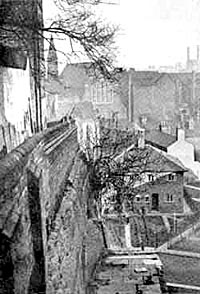< Previous | Contents | Next >
Long Stairs
 |
LONG STAIRS, now closed, which gave communication from Commerce-square, via Malin-hill (oft High Pavement, opposite St. Mary’s Church to Narrow Marsh (later Red Lion-street and now Cliff-road), probably began life ages ago, long before the Romans came to Britain, as a covered way leading from the low ground or marshes along the Leen, to the summit of the cliff some 90 feet above it; upon which stood the primitive settlement that has developed into Nottingham.
The rise of Long Stairs is from right to left, so that an enemy ascending it would be unable to use his shield as a defence against defenders stationed on the summit of the cliff.
A similar ‘covered passage is still to be seen in the Castle Cliff and as its roof has broken down in one or two places it is easy to learn from it how Long Stairs gradually became open to the sky.
Long Stairs’ history is somewhat sordid, being mostly concerned with murders and the like. In 1531, the year in which Henry VIII. was acknowledged the supreme head of the Church of England, a certain Edward Chamberlayne paid 2s. 5d. for a "little house and pinfold " on Long Stairs.
I presume that he wanted to use it as a pig stye.
About half-way up Long Stairs was to be found one of time half-dozen fig trees which clung to the sour soil of the cliff side, and in spite of deplorable atmospheric conditions managed each year to leaf and fruit.
They were rather pathetic memorials of the gardens of the gentry which at one time crowned the cliff, and from which might be enjoyed, in the days before industrial smoke, a magnificent view.
The demolition of the slums of the Marsh area, and the planning of a new residential estate by the Corporation, led to the closing of Long Stairs of which only the iron-fenced upper entrance on Malin Hill now remains.
